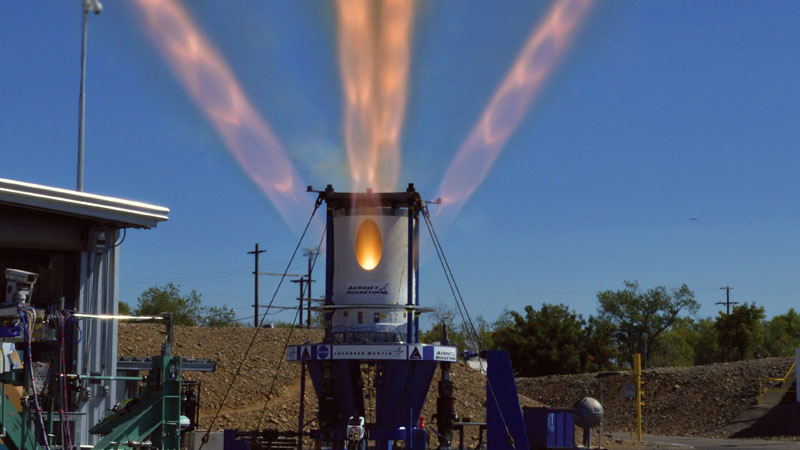Stay Up to Date
Submit your email address to receive the latest industry and Aerospace America news.
The Solid Rockets Technical Committee works to advance the art, science and engineering of solid rocket propulsion, and to foster dissemination of new knowledge in this field.
Solid rocket propulsion continued to set milestones in the industry with support to future and current launch systems and missile defense applications. The U.S. Navy launched an unarmed Trident 2 D5 fleet ballistic missile from the Atlantic Ocean in August. It was the 161st launch since 1989. Lockheed Martin built the missile as well as a test element of the Demonstration and Shakedown Operation 1, or DASO-27, to certify the submarine’s crew and weapon system. Both Aerojet Rocketdyne of California and Virginia-based Orbital ATK are major propulsion suppliers for the Trident 2 D5 missile.
Since NASA’s Space Launch System program passed its critical design review in late 2015, Aerojet Rocketdyne and Orbital ATK continued development on the Orion Launch Abort System and booster propulsion systems. The LAS consists of three solid-rocket motor systems: jettison motor, abort motor and attitude control motor. In August, Aerojet Rocketdyne completed its third jettison motor test. In June, NASA and Orbital tested the second five-segment qualification booster, QM-2, at Orbital’s facility in Promontory, Utah, at 4.4 Celsius, validating nozzle vectoring and motor performance and certifying the motor for flight.
Two or five Aerojet Rocketdyne AJ-60A solid rocket boosters per launch provided the thrust for liftoff of Atlas 5 launch vehicles. For first-stage separation, Orbital ATK provided eight retro motors per launch. Atlas 5’s boosted a Navy Mobile User Objective System-5 satellite and GPS-Block 2F-12 satellites into orbit and an Orbital ATK Cygnus cargo spacecraft to the International Space Station. Meanwhile, with the Delta 4 launch vehicle, Orbital ATK GEM-60 SRMs were used for U.S. Air Force and National Reconnaissance Office payloads.
The Air Force awarded Aerojet Rocketdyne and Orbital ATK hardware demonstration and trade study programs in February to evaluate propulsion improvements and upgrades for retiring intercontinental ballistic missiles such as the Minuteman 3. In late 2015, Orbital ATK conducted a technology demonstration test with a Medium Class Stage 2 SRM demonstrating advanced technologies for the Ground-Based Strategic Deterrent program. The U.S. Missile Defense Agency conducted several flight tests of ship-based systems. In a U.S.-Japanese flight test of Raytheon’s SM-3 Block 2A off the coast of California, the joint missile test demonstrated fly-out through kinetic warhead ejection. In addition, the Aegis Ashore weapon system was tested during a first intercept test using an SM-3 Block 2B missile. A flight test of the Ground-based Midcourse Defense system followed in January to evaluate the performance of alternate kill vehicle divert thrusters. In May off the coast of Hawaii, two SM-3 Block 1B upgrade tests were flown, validating nozzle improvements for Orbital ATK’s Third-Stage Rocket Motor. Both Aerojet Rocketdyne and Orbital ATK supply SM-3 propulsion stages and target vehicles for the MDA flight tests.
The U.S. Army’s PAC-3 Missile Segment Enhancement, or MSE, missile upgraded in 2015 continued testing this year. Aerojet Rocketdyne provides the primary propulsion and attitude control motors to Lockheed Martin. In July, as part of a post-deployment test program, missile testing confirmed the ability to detect, track, engage and intercept an aircraft declaring the missile ready for hit-to-kill capability against lower-tier threats.
From Europe, the VEGA launch vehicle entered into full commercial phase in 2016 with the PerúSAT-1/SkySats mission, launched in September. The VEGA launch vehicle has three solid propulsion stages: P80, Zefiro 23 and Zefiro 9, manufactured by Avio Spazio, in Colleferro, Rome. The Ariane 5 launch system, equipped with two solid boosters built by Europropulsion, reached more than 85 flights. Ariane 6 and VEGA-C, the new European launch systems, entered into the development phase this year. ★
Stay Up to Date
Submit your email address to receive the latest industry and Aerospace America news.




